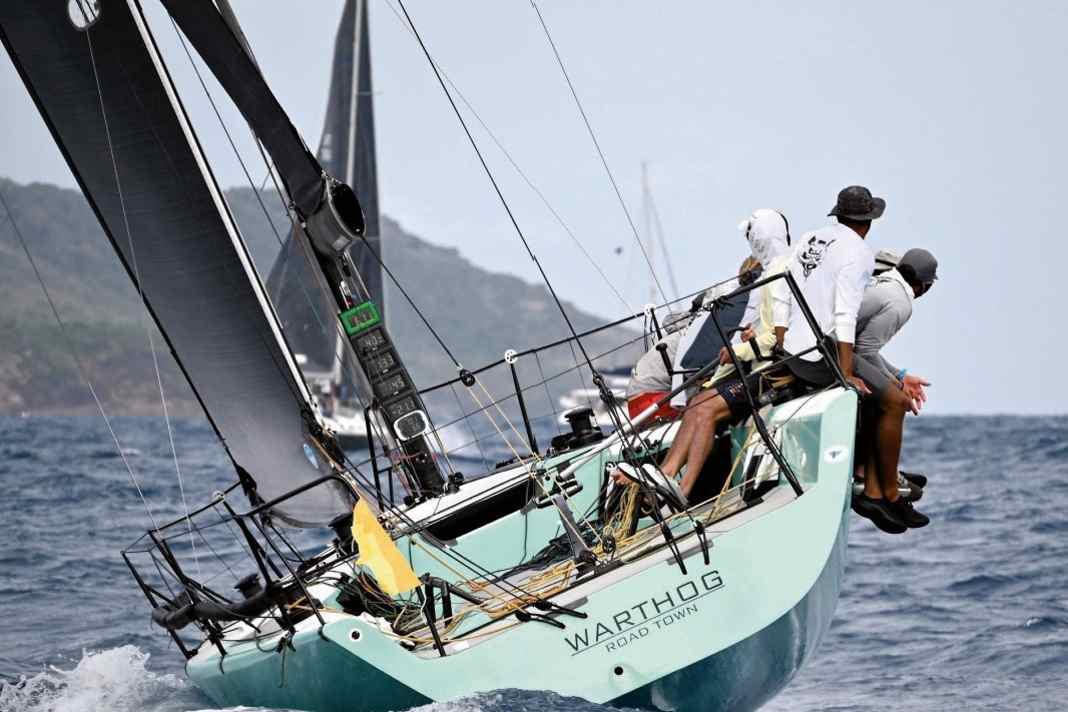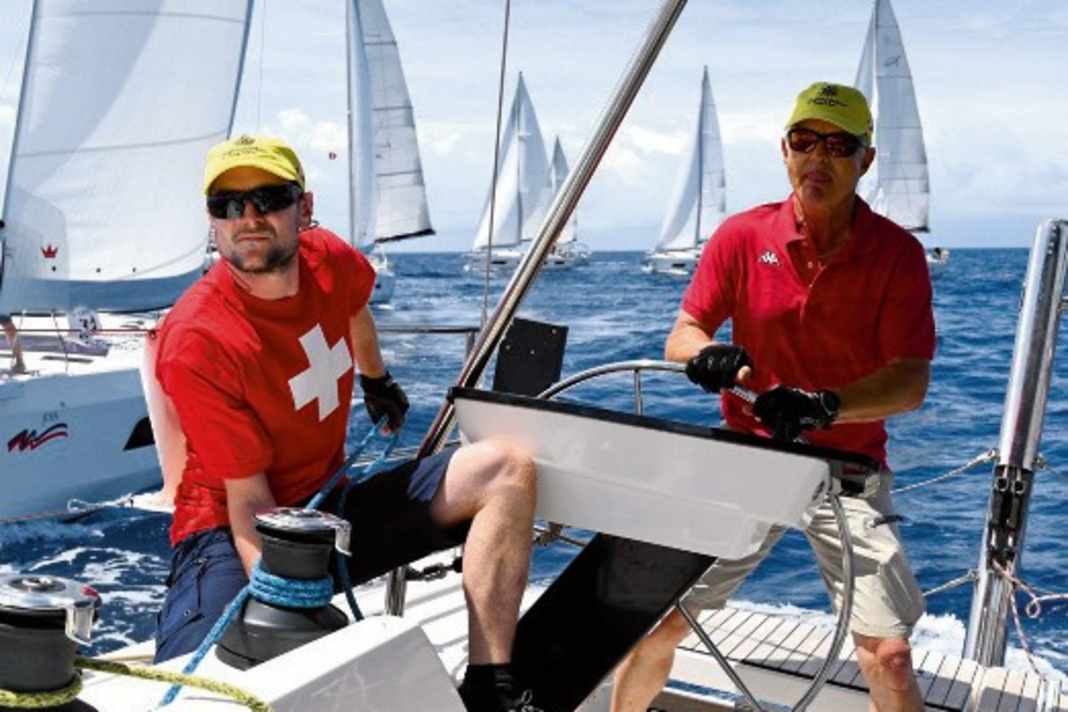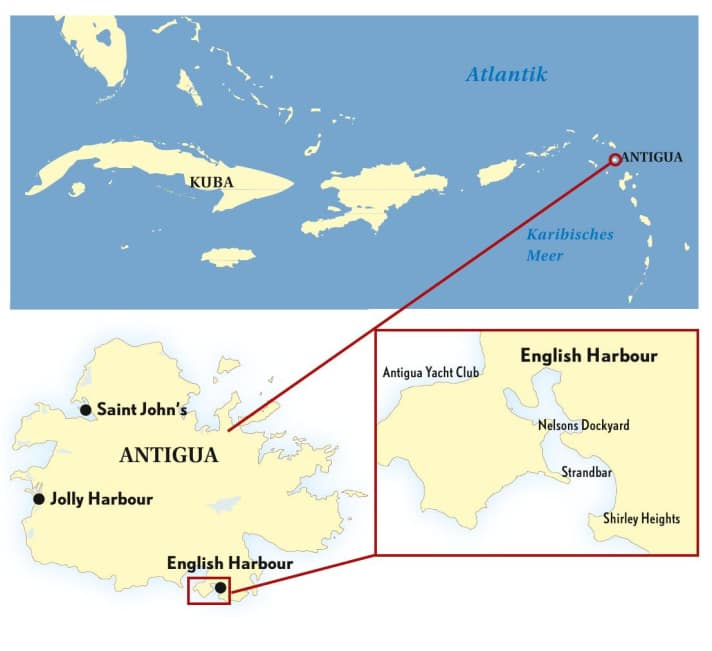Antigua Sailing Week: The mother of all Caribbean races - a feast for the senses
Fabian Boerger
· 06.06.2025






Three, two, one, start. A horn sounds directly to starboard. Skipper Lennart Davidsson pulls hard on the steering wheel of the "Kialoa III", which is the size of a tractor tyre, so that the over 30-tonne aluminium ship starts to luff. It gently lays on its side and crosses the starting line at high speed - a perfect zero start.
At the same moment, things get hectic amidships. "Let's go. Go, go, go," shouts a young man, cheering on two others who are cranking the grinders as if their lives depended on it. The sheets creak and crack on the iron winches, while hundreds of square metres of sail are gradually tightened. The "Kialoa III", 79 feet long, built in 1974 and designed by Sparkman & Stephens, rushes towards the windward mark together with three other racing yachts.
Ideal sailing conditions under the tropical sun
It's April and the fourth day of racing at Antigua Sailing Week (ASW) has begun. In Germany, temperatures are only hesitantly reaching ten degrees. Meanwhile, ideal sailing conditions prevail off Antigua: tropical 28 degrees, sunshine and a constant 10 to 15 knot trade wind. The "Kialoa III" won the race in Antigua for the first time in 1979. Now she is back. As the oldest yacht of a total of 53 boats, she is celebrating the end of the Caribbean regatta season off the picturesque rocky coast of English Harbour.
Since then, Antigua Sailing Week has developed into one of the most traditional races in the region. It was originally intended as a marketing tool to promote Antigua's sailing area. "It is now considered the mother of Caribbean regattas," says Alison Sly-Adams, President of Antigua Sailing Week.
Rising number of participants due to charter boats
In the early years, it was mainly the cruising yachts of the local hoteliers that competed off the coast. Later, as tourism became more popular on the island, more and more charter boats were added. This was accompanied by increasing numbers of participants. In the record years of the nineties, well over 200 crews took part in the regatta.




Originally, the course took the fleet around the island. This was a real highlight for many, as you could sail together and discover the country. But over the years, more and more racing yachts took part. Berths, toilets and interior fittings were upgraded in favour of performance, which made longer trips less comfortable. The organisers therefore concentrated the event at a central location.
Antigua Sailing Week is synonymous with great parties and lots of fun - both on land and on the water.
Since then, a large part of the event has taken place in English Harbour. The small town and natural harbour offers sailors an ideal infrastructure: restaurants, bars, sailmakers, riggers and boat chandlers are all within easy walking distance. The numerous live concerts, daily award ceremonies and festival-like events, such as "Reggae & Rum" or "Lay Day", also take place there.
Antigua Sailing Week: "Great party and lots of fun"
In addition to the competitive races on the water, many sailors appreciate the relaxed Caribbean atmosphere on land. "Antigua Sailing Week stands for great parties and lots of fun - both on land and on the water," says Lennart Davidsson.
That is one of the reasons why the skipper of the "Kialoa III" came to Antigua. He had previously spent several months in the Caribbean. With a colourful crew of a small regular crew, charter guests and locals, he sailed from regatta to regatta: first the Grenada Sailing Week, then the Caribbean 600 and finally the Heineken Regatta.



Participants mainly from the USA and Europe
He is not alone in this: Every year, numerous crews from the USA and Europe spend the winter in the Caribbean and return to their home waters in the spring. This year, sailors from sixteen nations will be competing. In addition to teams from the Caribbean and the USA, many Europeans are also taking part, particularly from the UK. Three German and one Swiss team are also taking part.
The south of Antigua in particular is considered a mecca for sailing:

The diversity is also evident in the boats: From 70-foot racing machines such as Roy Disney's Volvo 70 "Pyewacket" to J-Class yachts and Swans to charter boats, everything sails on the same regatta course. The crews are also a colourful mix: former and current Olympic participants, America's Cup sailors, amateurs and regatta newcomers sail together here. ASW President Sly-Adams emphasises: "For many, this is an inspiration."
Warm and windy: Caribbean races at a glance
- The Heineken Regatta on Sint Maarten is one of the biggest sailing events in the Caribbean and takes place every year at the beginning of March. Known for its motto "Serious Fun", the regatta combines four days of intense competition with evening parties that have already achieved cult status. 107 boats from 30 countries took part in the 45th edition of the race this year.
- The St. Barth's Bucket Regatta is particularly popular with fans of large yachts. This exclusive event for superyachts takes place every year in March on st. Barthélemy every March. Around 30 superyachts, whether sloop, ketch or schooner, as well as prominent sailors, including many America's Cup veterans, took part in this year's 31st edition. In addition to the sporting competition, as with many Caribbean events, the socialising of the participants also plays a major role.
- The RORC Caribbean 600 is a challenging offshore sailing race that starts annually in February from Antigua. Organised by the Royal Ocean Racing Club, the 600-mile course leads around eleven Caribbean islands. It is popular with top international sailors and high-calibre yachts. Three German teams took part in this year's 16th edition.
- The Spring Regatta, which takes place in the British Virgin Islands at the end of March, is known for its diverse racing categories and spectacular sailing conditions. This year, the fun regatta took place for the 51st time with 61 boats from 13 countries and attracted numerous sailors to the Nanny Cay Marina on Tortola. Fun is the top priority of the race. Similar to Antigua Sailing Week, guests can also take part via bareboat or berth charter on one of the regatta boats.
- Every year in April, directly before Antigua Sailing Week, the classic sailing scene also celebrates with the Antigua Classic Yacht Regatta the end of the Caribbean season. The spectacle has been taking place at the end of the charter season since 1967. Many of the noble classics then return to remote home ports across the Atlantic.
Read more:
Antigua Sailing Week is both a challenge and a fascination
This is a challenge for race director Jaime Torres. He has to take into account the different boats and experience levels while still ensuring a smooth and safe process. His solution: a variety of courses of different lengths. "We have planned long courses for the big boats, where the crews can let off steam and also set all the big sails," says Torres. The rest of the fleet mostly completed shorter courses.
But regardless of the class they sail in, they all have one thing in common: the breathtaking panorama of the south coast with its rugged cliffs, turquoise waters and vibrant, warm colours. According to Torres, it is these views, coupled with the consistent conditions, that make Antigua Sailing Week so special.
At this point, you will find external content that complements the article. You can display and hide it with a click.
Great landscapes and thrilling races
Away from the picturesque landscapes, the teams engage in thrilling battles on the water. While Roy Disney's "Pyewacket" clearly dominates the field of Volvo racers, the other three of the four racing classes are hotly contested. The "Wave Walker", a US Swan 58, took victory in the second racing class. The "Kialoa III" finished in last place. However, it is also by far the oldest ship.
The Italian "Caccia Alla Volpe", skippered by Carlo Falcone, the former Olympic sailor and father of Shannon Falcone, who has already taken part in the America's Cup and the Volvo Ocean Race as a crew member, won the largest group of the regatta.
"El Ocaso" wins Lord Nelson Trophy
The most important victory was once again won by Briton Steve Rigby and his crew. They win the Lord Nelson Trophy for the third time in a row with the chartered J122 "El Ocaso". This trophy is awarded to the boat with the fastest corrected overall time based on the distance sailed. "We are really very pleased. It feels like the most competitive regatta 'El Ocaso' has ever taken part in," says Rigby.
In the bareboat class, in which mainly charter yachts sail, the Swiss crew led by skipper Jakob Oetiker came out on top. The retired surgeon from Zurich is already an old hand at Antigua Sailing Week. He took part for the first time in 2004 and has returned every two years or so since then.
It's a mix of Caribbean feeling and sporting competition: Europeans love that - and I'm certainly not the only one. Jakob Oetiker
All other results you will find here on the page of the Antigua Sailing Week
Germans at Antigua Sailing Week mainly in bareboat class
Participation with locally chartered boats is particularly popular with German-speaking sailors. They have been strongly represented for many years. This year, three of the ten registered bareboats came from Germany and one from Switzerland.
This is partly due to the commitment of the German charter company KH+P. According to the organisers, no other organisation has brought more crews to Antigua Sailing Week. The company helped to promote the regatta in Germany at an early stage. In 1997, the participation of German-speaking teams reached its peak with 40 crews. In the following years, the average was 17 crews.
Declining participant numbers for several years
However, these times are over. In recent years, the number of participants has fallen steadily. According to the organisers, they have levelled off at around 100 boats. This year there were even fewer: only 53 crews registered in 2025.
There are several reasons for this. Firstly, the number of regattas and fun events in the Caribbean continues to grow. There are three in Antigua alone: Antigua Sailing Week, the Caribbean 600 and the Antigua Classic Yacht Regatta. And there are more in the immediate vicinity - including the Heineken Regatta and the Spring Regatta in the British Virgin Islands.
Read also:
Secondly, the regatta season in the Mediterranean and on the US East Coast now starts earlier. The Palma Vela on Mallorca, which used to take place in May, now falls on the same date as Antigua Sailing Week. And Charleston Race Week on the US East Coast, one of the biggest sailing events in North America, takes place two weeks earlier in mid-April. For many of the racing yachts, this means that they will have to return home from the Caribbean earlier than usual and will no longer be able to take part in ASW.
New concept for Antigua Sailing Week 2026
The organisers of Antigua Sailing Week have therefore revised the previous concept. Firstly, a new event, Antigua Race Week, is to be introduced. It will take place a month earlier, from 18 to 22 March, and is primarily intended for pure racers and ambitious crews.
At the same time, the traditional Antigua Sailing Week will focus more on cruising yachts and catamarans, the number of which has increased significantly in the Caribbean. The new format should be better suited to this development and be more accessible and fun-orientated, similar to a rally, says ASW President Sly-Adams.
All info for the Antigua Sailing Week you will find here.
The exact date has not yet been finalised, but the event will take place a few weeks earlier than before. Sly-Adams explains: "The Antigua Racing Week is intended to meet the requirements and competition of the racing boats, while we also want to create a suitable offer for the cruisers."
"The place to be"
At the end of May, Lennart Davidsson will also sail back to Sweden on the "Kialoa III", as the next regatta is already on his list: the Round Gotland Race at the end of June. For him, Antigua Sailing Week is the festive conclusion to the Caribbean season. Davidsson says: "It's the place to be at this time of year."

